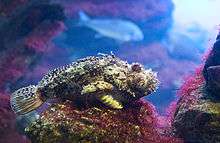Black scorpionfish
The black scorpionfish (Scorpaena porcus) is a venomous scorpionfish, common in marine subtropical waters. It is widespread in the Eastern Atlantic Ocean from the British Isles to the Azores and Canary Islands, near the coasts of Morocco, in the Mediterranean Sea and the Black Sea.[3]
| Black scorpionfish | |
|---|---|
 | |
| Scientific classification | |
| Kingdom: | Animalia |
| Phylum: | Chordata |
| Class: | Actinopterygii |
| Order: | Scorpaeniformes |
| Family: | Scorpaenidae |
| Genus: | Scorpaena |
| Species: | S. porcus |
| Binomial name | |
| Scorpaena porcus | |
| Synonyms | |
| |
Description
The black scorpionfish has a maximum length of about 37 cm (15 in) but a more normal adult length is around 15 cm (6 in). The head is broad with a short snout and upwardly angled mouth. There is a short tentacle just above the eye and various other shorter tentacles, spines and flaps of skin decorating the head. The dorsal fin has twelve spines and nine soft rays and the anal fin has two spines and six soft rays. The pectoral fins are large and oval and have sixteen to eighteen rays. The colour of this fish is generally brownish and there is a dark pigmented spot between the eighth and ninth dorsal spines. The fins are mottled with brown and the caudal fin has three vertical brown stripes. [4]
Distribution and habitat
The black scorpionfish is native to the eastern Atlantic Ocean, the Mediterranean Sea and the Black Sea. Its range extends southwards from the southern half of the British Isles to the Azores, the Canary Islands and the northwestern coast of Africa. It is found throughout the Mediterranean Sea and the Black Sea down to depths of about 800 m (2,625 ft).[3]
Biology
The black scorpionfish is a benthic species and is usually found resting among seaweed and on rocks. It is usually solitary, and it feeds on small fishes such as blennies and gobies, crustaceans and other bottom-dwelling invertebrates. Little is known about its reproduction.[4] This is one of the fish used by the marine leech Pontobdella muricata as a host.[5]
References
- NatureServe (2013). "Scorpaena porcus". IUCN Red List of Threatened Species. 2013. Retrieved 15 December 2014.CS1 maint: ref=harv (link)
- Bailly, Nicolas (2013). "Scorpaena porcus Linnaeus, 1758". WoRMS. World Register of Marine Species. Retrieved 2013-12-19.
- Scorpaena porcus at FishBase
- "Black scorpionfish (Scorpaena porcus)". Fishes of the NE Atlantic and the Mediterranean. Marine Species Identification Portal. Retrieved 2013-12-19.
- "Pontobdella muricata Linnaeus, 1758". SeaLifeBase. Retrieved 27 December 2019.
External links
- Photos of Black scorpionfish on Sealife Collection
